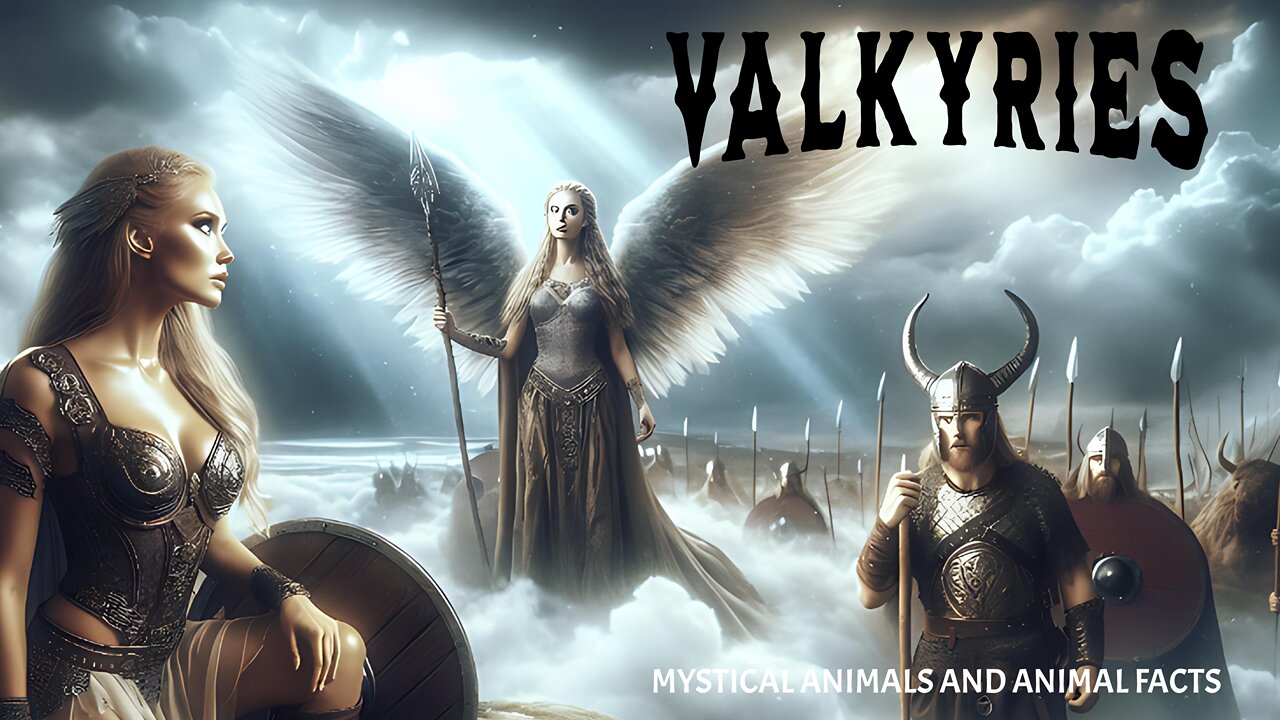Premium Only Content

Valkyries Mystical female spirits - mini documentary
Shirts and more
Designs Redbubble
https://www.redbubble.com/people/ReneMM/shop?asc=u
Spreadshirt.at
https://www.spreadshirt.at/shop/user/renemm/?srEdit=pa#?affiliateId=1257693
Spreadshirt.com
https://www.spreadshirt.com/shop/user/renemm/?srEdit=pa#?affiliateId=11625
Shirtee.at
https://www.shirtee.com/de/catalogsearch/result/index/designer_id/112048/all_stores/
1/
Pictures
https://fineartamerica.com/profiles/rene-mitterlehner
The Valkyries, originating from Norse mythology, are female beings who function as servants of Odin in the imagination of the Germanic peoples and play a central role in the context of war, death and the afterlife. Their name is derived from the Old Norse “valkyrja”, which means “she who chooses the fallen”, and refers to their primary task: they ride across battlefields on wingless horses to select brave warriors who have fallen in battle. These chosen ones, called Einherjer, are led to Valhalla, the hall of Odin, where they prepare for the final battle during Ragnarök. The Valkyries not only act as soul guides, but also embody the connection between the fate of mankind and the will of the gods, especially Odin, who influences the composition of his army through their selection. Their appearance is often described as both warlike and supernatural - armed with helmets, spears and shields, sometimes accompanied by ravens or wolves, symbolic animals of Odin. In mythical tales such as the Völuspá or the Grímnismál, they are portrayed as active agents who are not just passive messengers but can also intervene in battles, for example, by decreeing victory or defeat. Their names often reflect martial attributes such as “fight”, “victory” or “battle”, which emphasizes their role as determiners of fate. In addition to their martial function, Valkyries also have ritual and cultic aspects, as they were possibly worshipped in Old Norse societies as mediators between the living and the ancestors. Archaeological finds such as amulets or picture stones point to an iconographic representation that shows them as riders or with drinking horns, the latter as a reference to their role in entertaining the warriors in Valhalla. The relationship between Valkyries and mortals in sagas is ambivalent: on the one hand, they embody the ideal of heroic longing for death; on the other, tales of Valkyries leaving their divine role to experience human love show a complex interpenetration of the divine and the human. Their existence reflects the martial ethics of the Viking Age, in which an honorable death in battle was considered desirable and the Valkyries served as the embodiment of these values. At the same time, they symbolize the unpredictability of fate, as even the bravest could not be sure of being chosen by them, a decision that ultimately depended on Odin's strategic calculations. In cultic practices, Valkyries may have been invoked as protective deities during battles, although their worship is less clearly identifiable than that of other Norse deities. The tradition of the Valkyries is mainly preserved in literary sources such as the Song Edda and the Snorra Edda, although their depiction is sometimes contradictory: sometimes they appear as anonymous collective beings, sometimes as individual figures with their own narratives. This dualism between anonymous office and personalized mythology underlines their function as both archetypal and narrative elements of Old Norse cosmology. Their connection to other supernatural beings such as the Norns or Disen remains controversial in research, but they share with them the role of determiners of fate. The Christianization of Scandinavia led to a reinterpretation of the Valkyries, who were partly demonized in medieval sources or adapted as allegorical figures of Christian moral concepts. Nevertheless, their image remained present in folk tales and regional customs, often mixed with beliefs in fairies or spirits. In their original form, however, the Valkyries primarily represent the direct link between war, honor and transcendent reward that shaped the world view of the Nordic peoples. Their ambivalent nature - between life and death, power and submission, divine duty and human emotion - makes them a central symbol of the duality of the heroic in pre-Christian Scandinavian mythology. Valkyries are interesting mythical creatures. I would really appreciate a like and a subscription.
-
 1:05:22
1:05:22
Timcast
1 hour agoLiberals Claim TRUMP DIED Or Is Dying And Will RESIGN Today At 2pm
27.4K45 -
 LIVE
LIVE
Sean Unpaved
55 minutes agoGridiron Shocks: Arch's Rough Start, Belichick's Tar Heel Tumble, & NFL Week 1 Buzz
313 watching -
 LIVE
LIVE
The Dilley Show
1 hour agoChicago in the Crosshairs, Grifters Crash Out and More! w/Author Brenden Dilley 09/02/2025
4,312 watching -
 LIVE
LIVE
Viss
1 hour ago🔴LIVE - How To Win in PUBG - PUBG 101
260 watching -
 LIVE
LIVE
Side Scrollers Podcast
2 hours agoVoice Actor ROASTED For Racist Double Standard + Influencer FELONY After Con Threat | Side Scrollers
858 watching -
 1:53:25
1:53:25
Steven Crowder
3 hours agoThe CDC Exodus: RFK Forces Self-Purge of the Corrupt Elite
202K128 -
 LIVE
LIVE
The Rubin Report
2 hours agoDave Rubin Can’t Believe This Happened While He Was Off the Grid | Jillian Michaels Guest-Hosts
2,424 watching -
 LIVE
LIVE
Rebel News
39 minutes agoFather killed in home invasion, Predator targets toddler, Who's destroying Canada? | Rebel Roundup
281 watching -
 UPCOMING
UPCOMING
TheAlecLaceShow
1 hour agoTrump Health Hoax | Warp Speed Truth | UK Protests | Guest: Sheriff Mack | The Alec Lace Show
39 -
 LIVE
LIVE
The Mel K Show
1 hour agoMORNINGS WITH MEL K - Liberty, Privacy, Sovereignty & Justice: The Battle Ahead 9-2-25
1,108 watching